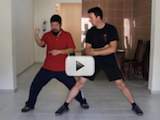1. Beginning. 2. Hand-Elbow connection. 3. Movement and tranquility relationship. 4. Suspended (stretched) force. 5. Transfer of power through a fixed point. 6. What does smooth mean? 7. Lock contacting point and transfer power out. 8. Finger and body connection. 9. Use the trained technique. Don’t come up with your own applications. 10. Lunch. 11. Locations of power and impact. 12. Repacking the body vs collapsing. 13. Working with space. 14. Pivoting point for movement. 15. How to wrap around the line.
Presenter: Chen Zhonghua Length: 70 min. In: English Year: 2012 Difficulty:3/5 At:Berlin, German
“2012 Berlin Private Workshop 1” Online Video Trailer
Previous post: Toronto Workshop Videos on new video server
Next post: Half way through Yilu choreography



{ 1 comment… read it below or add one }
Chen Zhonghua is a very generous master with outstanding teaching skills. This video of him teaching at a workshop is a treasure chest full of gold nuggets that can greatly advance one’s push hands knowledge and skills. You will be amazed at the down-to-earth simplicity of explanations AND of the actual and non-choreographed demonstrations by one of the greatest masters of the present day. Without a doubt, it is a precious and a must-have for intermediate and advanced practitioners. That being said, it still requires immersive learning and dedicated training to fully appreciate the authoritative and cogent transmission of this lineage of Chen Style (practical method) taijiquan. [By the way, the video and the audio qualities of this recording are excellent.]
Contents:
1. Beginning. 2. Hand-Elbow connection. 3. Movement and tranquility relationship. 4. Suspended (stretched) force. 5. Transfer of power through a fixed point. 6. What does smooth mean? 7. Lock contacting point and transfer power out. 8. Finger and body connection. 9. Use the trained technique. Don’t come up with your own applications. 10. Lunch. 11. Locations of power and impact. 12. Repacking the body vs collapsing. 13. Working with space. 14. Pivoting point for movement. 15. How to wrap around the line.